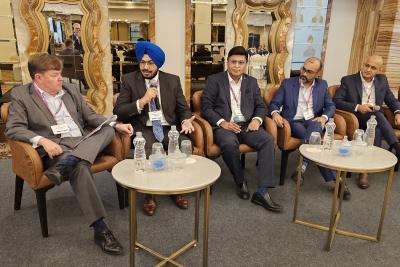Publications & Thought Leadership
Independent Wealth Management in Asia - The State of the Market & What Lies Ahead

Aug 3, 2020
The second of two illuminating virtual discussions on the independent wealth management industry in Singapore took place on July 22, when the invitees – all leaders in their particular segments of the Asian wealth management industry – offered their expert insights into the evolution of the sector and what should take place to further boost the depth and penetration of the firms involved. Their analysis was focused specifically on the state of the independent wealth management industry in Singapore, although the broader trends and lessons emanating from the discussion are indeed valid for the wider Asia market, especially Hong Kong. For the purpose of the discussion, the acronym IAM throughout collectively represents all such independent firms, including independent and external asset managers, as well as family offices. The discussion ranged over the challenges and opportunities for these IAMs for the foreseeable years ahead, including how the independent community is facing up to the restrictions caused by the pandemic. The experts mulled over what they think are the key priorities, from further digitalisation to the greater use of digital execution and custody platforms, or the hiring of more and better relationship management talent. The panel considered what will add more value to the independent model, whether it is consolidation, partnerships, more top-flight RMs or more and better CIO-type talent, or perhaps greater digital accessibility and an enhanced user experience, or perhaps a broadly more professionalised business structure and more efficient, lower-cost processes. The panel considered how the IAMs could achieve more predictable revenue from advisory and discretionary mandates, and gradually evolve clients from self-directed investing to a more institutional type approach. And our experts looked at how the industry can work separately and collectively to enhance their brands and the image and reputation of the independent advisory and asset management community at large.
The Key Observations
IAM status report – great progress in the past decade, but could do considerably better
The Singapore AIAM was created in September 2011, just around the time that the independent wealth management sector was starting to take wing. Progress to date, the experts agreed, has been fairly good in terms of numbers of players and penetration, but everyone agreed that given their fundamental view that the private bank model is not the optimal solution for HNW and UHNW private clients, and given the rapid growth in Asia’s private wealth in the past decade, they all believe it can do better.
Patience and focus required
The penetration of the wealth markets by the IAMs in Europe, especially in Switzerland, is considerably more advanced, but that has evolved over several decades. Singapore’s IAM sector is barely a decade old, and to take it to the next stages of development, requires careful planning and nurturing.
Reputations must be preserved and enhanced
The AIAM accommodates firms irrespective of the business models they adopt, whether advisory, discretionary or self-directed, or any combination of the above, as long as 50% of more of their revenues are from the independent advisory and asset management models. It is vital to safeguard the reputation of the sector, so a combination of regulatory hurdles and AIAM’s checks help maintain integrity.
Whatever the fee model, transparency is essential
Whether the IAMs adopt a pure fee-for-advice model or more of the traditional private banking approach that has long prevailed in the region of earning trailer fees, or retrocessions, the panel agreed that absolute transparency is the key ingredient so vital in all client dealings.
Education all round is essential
The IAM sector is relatively young, and clients need more education on what the IAM model represents compared to the private bank offerings, and how the IAMs can help the private clients and their families with a more holistic and inclusive wealth management offering.
Exploiting some underlying reservations about the private banks
The IAMs want to press home the message that their approach is more client-centric than the private banks, which they believe too often focus on internal revenue targets and remuneration packages that appear to present some conflicts of interest.
But the banks are big and fight tough
But the private banks include some major global brands and powerhouses, and of course they are lenders too, so it will naturally take time for the IAMs to win more clients as well as a larger share of wallet from existing clients.
New custody options now offer IAMs great independence and enhanced client offerings
The IAMs and their clients today are no longer completely tied to the banks for custody. While many HNW and UHNW clients will prefer to retain custody with their private banks, even if they shift their main attention to an IAM, there are more options amongst the larger digital execution and custody platforms.
Genuinely open architecture is also completely within the reach of the IAMs
The independent model thrives on its adherence to the concept of objectivity, so access to the larger, rapidly expanding digital and online execution platforms in the market is increasingly appealing to the IAMs, as those platforms offer both open architecture and well-designed, high-quality user experiences, which then of course feeds through to the IAMs’ end clients themselves.
Talent is not only about skills and experience but also about character and style
The IAM sector is continually on a quest for talent, but it is not all about finding the most technically competent or most experienced bankers; they must also fit the entrepreneurial style and character of the IAM industry. Similarly, for those wanting to leave the safety of the big banks and go out on their own, they must have the character and resilience required to venture out from the corporate blanket.
Segmentation is not for the IAM community
The segmentation approach towards clients in different wealth categories and geographies by many of the banks can be frustrating for the bankers, whereas the IAM model offers the RMs joining the IAMs a much more entrepreneurial approach and less formalised way of conducting their business. The mission is to offer a discrete and tailored service and institutional level advice and execution at every turn possible for the HNW and UHNW clients, essentially most individuals or families generally with investible assets of USD3 million and above. Clearly, there is more to do for the UHNW clients, but the model is generally the same throughout.
The IAM model is individualised and for individuals and must promote best-of-breed
The IAM model is not driven by the brand on the card; it is driven by individuals and service. To achieve this, the IAMs must be able to deliver the best advice and solutions from within their ecosystem of friends and partners, for example pulling in different experts for wealth planning, for consolidation of assets, for different types of assets, for legal matters, tax advice, accounting, investment migration and so forth. The best of breed mentality must dominate at all times.
Outsourcing is in the rise across the proposition; it is the IAM’s uniqueness that wins clients
Aside from outsourcing of execution and custody, the IAM sector today has the ability to outsource almost any functions from compliance, the back and middle office, IT, communications and other key functions to third-party firms and experts, for greater efficiency and lower costs. But the vital element they must retain and focus on is their unique skills and expertise.
Greater consolidation is likely to take place, but character and style must gel
Consolidation in the IAM industry, if approached properly, will help the IAM community achieve synergies in terms of services, clients, as well as some reduction in costs at the middle and back offices. Compliance costs are a particular bugbear as they keep rising, and this alone might drive some of the smaller players towards selling or partnerships, and so too the drive towards digitalisation, which is both expensive and easy to get wrong. The vital element in all such activity is to ensure a meeting of minds and styles between the IAMs.
Technology adoption is a necessity, but make sure you get it right
There is too much technology friction within the industry, too many different solutions that do not work well together, for example between the IAMs and the banks which offer execution and custody. But digitalisation is a vital requirement for private clients, and especially for the younger holders of Asia’s wealth. To achieve their technology goals, the IAMs must first identify what they want to achieve, and then take a step by step, modular approach.
IAMs call for greater communication and openness in their community
Some panel members called for greater cooperation between firms to curate better investment and other solutions for the private clients they serve while retaining client privacy and the integrity of their relationships. This might be a difficult juggling act, but the idea is that the pooling of their collective expertise will ultimately benefit themselves as advisors, their clients and the industry as a whole.
Make sure you keep a multi-generational focus
The IAM community knows as well as anyone else how much the younger generations in Asia will inherit in the decade ahead and it is in the trillions of dollars. The IAMs must therefore do everything they can to service their existing clients while reaching out to build their relationships with the nextgens.
Collective responsibility and collective communication will result in a stronger IAM industry
The panel expressed their confidence in the IAM sector in Singapore and more broadly in Asia and maintained that by working together their industry sector can raise its profile and gather more clients and more assets under management.
The Discussion
An expert opened the discussion by recalling that the Singapore AIAM was born in September 2011. “If you had asked me then where we would be by 2020, I would probably have said we would by now be a bigger association,” he said, “but that does not sway me in any way from my fundamental view that the private bank model is not the optimal solution for HNW and UHNW private clients. I am not disappointed about where we have got to today, but I am hopeful that there will be more entrepreneurial type bankers wanting to leave their banks and establish independent firms.”
Good progress, more to be achieved
A fellow panellist agreed, adding that the European model, especially the Swiss template, although it evolved steadily over several decades, pointed the way ahead for Singapore, and he had therefore expected a sharper rise in numbers and depth of the independent sector in Singapore by now.
“Nine years down the road in Singapore we have actually achieved some good diversification, away from only firms with a European background and with more pure Asian firms opening up, so the landscape is becoming more interesting and varied. Of course, there were some firms that did not survive, as this takes more than a few good bankers, a nice office and money; it requires careful planning and nurturing. Moreover, the regulators here in Singapore and in Hong Kong have considerably more stringent requirements now, and those help weed out some of the less professional parties and have actually helped advance the quality levels generally.”
An accommodating model
The experts agreed that the association accommodates firms irrespective of the business models they adopt, whether advisory, discretionary or self-directed, or any combination f the above. “A black sheep can always tarnish the reputation of the industry,” said one panellist, “but there are plenty of regulatory hurdles and also quality checks in place at the association level when they admit members to hopefully ensure that there is a professional and viable approach. The association has in fact in the past rejected applicants for certain reasons, following certain due diligence on them and their activities.”
“In general,” another guest noted, “applications are approved providing they are locally incorporated, licensed and 50% or more revenues come from advisory within the independent space. Whatever revenue model the firm chooses, with pure fee-based, or whether driven by retrocessions, that is their choice, and that model remains quite prevalent in Singapore, following the long-time private banking model, rather than the fee for a service type of arrangement, especially as so often clients don’t prefer to pay you for your service, they want to pay related to the products they use.”
Transparent to the core
He did, however, advise that transparency is always the best way forward, so declaring to the clients where the fees are originating from is far better than leaving things opaque. “Regulatory evolution might drive these changes ahead,” he commented, “and we have seen that in Europe. The association in fact encourages members to actually charge a fee for the service rather than say our services are free but you the clients will pay us via other channels or distributions, even though the clients here generally understand and accept that type of trailer-fee arrangement. The key is to be open and transparent.”
Education required
A guest highlighted how the IAM sector is relatively young and clients need more education on what the IAM model represents compared to the private bank offerings. He remarked that the Singapore regulator is both tough in terms of rules but also market-oriented in terms of doing its approach to new firms setting up, with incentives for family offices, with new offerings such as the Variable Capital Company (VCC), and with other government-related initiatives, such as work permits, family visas and so forth.
A guest noted that on the MAS website while there are some 934 fund managers listed, all of which are CMS licensed managers, venture capital fund managers and registered fund management companies, his own estimate of the number of pure IAMs is around 100 in all IAM categories. “This is an interesting community,” he commented, “and my own view is that the IAM model is valuable from many viewpoints and is a valued part of the financial ecosystem here.”
Reinforcing the independent message
He added that many of his private clients are not greatly enamoured with the private banks anymore, and many of them date their reservations back to the global financial crisis and aftermath.
“Many of them felt and still feel that there is miss-selling, misrepresentation, and they seem to quite like the EAM, single-family office or multi-family office concepts. Then it comes down to what level of discretion they take up, or what type of advisory model they prefer, the latter with more checking back with the clients. Anecdotally, based on the kind of north Asia, Chinese, Singaporean and Indonesian clients we have, they like more control, and while they are happy to work with the IAMs they will generally take a considerable time for they fully trust them and reduce their own control over investments and transactions generally.”
Controlling the elements
Nevertheless, despite this preference for more control, he observed that the pendulum will continue to shift towards the more independent approach, but little by little. “Yet at the same time,” he said, “the banks still have a huge amount of power and a huge amount of leverage. They can offer things that the IAMs cannot and lending is the major one. However, unless the banks get very smart and improve their discretionary offerings so significantly, I believe the IAM model will grow, due to its client centricity, and its more holistic approach.”
Another expert commented that the Swiss model is more one of reputational excellence and self-governance, and that has helped the industry shift to a few for service model. He said that Singapore to some extent is following that lead through the AIAM, which is helping the IAMs direct their services and their integrity and their offerings in the right directions.
Outsourcing – the options flourish
He also observed that there can be further shifts towards truer independence, away from the banks as custody providers. Less dependence on the banks for custody, and perhaps some other advances such as a common onboarding and KYC system approved by the regulator would help enhance the image of greater autonomy and efficiency can also be enhanced by, for example, having one external Singapore back office providing back-office services for all the IAMs, with everything not needing real differentiation put into that pool.
Regarding custody, one expert remarked that the expansion of platforms and technology-related banks offering alternatives to the traditional incumbents, some of whom are withdrawing from that space, is greatly to be welcomed, in terms of cost-effectiveness, for lessening dependence on those banks, and also in the offering of a much more technically proficient and user-friendly interface with the IAMs, and one that the independents can then use with their clients to enhance their interface and user experience.
“These are discussions and thoughts that we have been talking about when I was back in Switzerland, and for example by outsourcing the compliance and risk management pieces are possible, as individual names are not needed for that. These and other ideas would help give us a competitive advantage. There is a lot of home-grown expertise here now that we should take advantage of that and try to build something more intelligent than the rest of the world has done, learning from the historical mistakes which have been made by other independent or wealth management centres.”
An expert added his insights regarding the historical dependence on the banks for custody. “Do we really need the private banks for custody? Probably not. We can do that with a global custodian. Do we need the private banks for execution? Probably not. We can do that through the online digital platforms and brokerage firms. Of course, it means all the plumbing has to be upgraded, and the convenience of doing it through a bank is obvious, you have a one-stop shop, but I think the industry will shift further towards fuller autonomy from the banks over the next 10 to 15 years.”
Steering away from segmentation
Another expert indicated that many IAMs are flexible on the scale of the client’s wealth, offering the same type of individualised service to clients with perhaps USD3 million as USD30 million. “The offering is tailored to the individual,” he said, “but we do not segment as such, we offer the same quality and approach throughout.”
Another expert observed that the segmentation approach of the banks across wealth categories and geographies can be frustrating to the bankers at the banks, whereas the IAM model offers them a much more entrepreneurial approach and less formalised way of conducting their business, manage the time they want to spend on certain clients, activities, procedures and so forth, providing of course this is all within the regulatory parameters.
“There is flexibility in the IAM model as to the scale of the clients they take on and we find that most IAMs will happily take on a two or three million dollar client, they are perfectly serviceable with a certain limited effort. As long as you can justify your efforts and expenses in terms of time and money, any client that fills the regulatory requirements should be welcomed because really this is very often just a foot in the door and then more can come in. The beauty of our setup is it is scalable - more can come without us doing all that much more.”
Talent in the IAM sights
The discussion turned to the quest for talent and the motivation for top bankers to move to the IAM sector, or event to establish their own business. “I think we will see more people going independent when the client asks his RM to leave the bank and join an independent job, and actually one such RM is joining us precisely because the client said he likes the RM but he wants the RM to do more for him and his family and therefore needed him to look after his entire wealth across different banks. I think we will see more of this as an industry.”
A guest attending the discussion pointed to the value offered by the IAMs, arguing that the greater attention on the holistic approach is highly valued by clients, many of whom are genuinely fed up with the banks pushing them individual products which most likely benefit the banker and the banks.
“I see that in private banking in general and we see more top bankers who have these relationships that adopt this holistic approach leaving the banks and they are going towards IAMs or starting out on their own,” he observed. “And at the same time, clients are becoming more accepting of the fee for advice model, given the disillusion with the product type approach of the banks.”
The individual counts
He added that the IAM model is not driven by the brand on the card, it is driven by individuals and service. “I think this is a very crucial differentiating factor where the client feels he is well taken care of by an individual who has the resources to deliver what those big banks might be able to deliver, but with a much more personalised effort and a concerted approach where we can pull in the experts for wealth planning, for consolidation of assets, for different types of assets, and therefore for a much broader, holistic approach to the needs of those clients, and without the problems within the banks of crossing lines of service, segmentation, product origination, rather than as with the banks so often working with limited numbers of fund companies or product originators because they pay certain commissions. This is where we achieve the goodwill with the clients, many of them being entrepreneurs as well.”
Consolidating concepts
A lawyer present then talked about possible consolidation in the industry, which if handled well he said would give synergies in terms of services, clients, as well as some reduction in costs at the middle and back offices.
“Consolidation is something that we are seeing more enquiries on form this sector, and the MAS we understand is open to this at the right level and right combination,” he explained. “We know compliance costs keep rising, and as things stand that will be never-ending, so that is another area where consolidation and cooperation will help. The more we see this, the better the end proposition for the IAMs and for the clients, who will then have wider access to credible professionals, very efficient service providers, reasonable fees, I think it will all piece together.”
Pooling expertise and resources
“Absolutely correct,” came another voice. “I am somewhat biased towards actually trying to pool certain activities, tasks that need to be taken care of in particular compliance and internal audit, technology, and other areas where we can benefit from scale, but clearly there are other key areas you should not pool, as you must continue to differentiate your business from other businesses. For me, it is very much about achieving that balance of what you want to do, the service you really want to provide, how you differentiate yourself, while at the same time achieving some scale, cost efficiencies, outsourcing and generally greater flexibility in operations.”
An expert took up the floor on the issue of technology, remarking that this will also help sidestep the issue of being prone to price increases when outsourcing some operational elements of the businesses. “One of the wishes I have,” he explained, “is for the banking sector to adopt some form of standardisation of interfaces to help reduce the costs of technology and the complexities, so for example you could just log in and consolidate different bank accounts. We need more solutions that are available step by step in building blocks, as many smaller IAMs cannot invest huge sums at one time.”
Reducing digital friction
A fellow panellist agreed that there is too much technology friction and a crusade needs to be expedited to eliminate that. “Technology interface is fundamental, but it is easier said than done and I see this every day, where technology systems are not working in conjunction with each other. Standardisation of APIs is only happening now in the broader finance and banking industry, but we have much further to go in the wealth sector. It is going to take time, but I think we need to work as resolutely as we can towards it as that is when you start to attract the best RMs, the best bankers because you can offer them a frictionless environment. This is what I dream of from business point of view.”
Another guest said his main hope is to see more players. “For the next five or so years, I would like to see the numbers double,” he said. “I do not see this as competition, I see it as reinforcing the value statement of the independent sector. For our firm, I want us to stick to what we do today and get better at that, while not trying to do things we are not so good at, so we will outsource, technology or IT, or compliance, accounting, HR, whatever we can efficiently and effectively. We can then truly focus more effort on the core of what we do and represent.”
Sharing but still caring
An expert said he would like to see more formalised sharing of opportunities and ideas, clearly with confidentiality being respected, but with the idea of leveraging the expertise of different firms across the industry, potentially all coordinated through the association or another body. “This would greatly benefit us as firms and our clients,” he commented.
A panellist agreed, noting that this did not need to be a marketplace, but greater openness and accessibility to concepts, ideas, products, new asset classes, investment opportunities. “It makes a lot of sense to kind of semi-formalise this type of information sharing, at least among the members,” he said.
Stay true to your USP
Another guest commented that the IAMs must stay true to their niches to keep and attract more clients and more high-quality RMs, and also to appeal to some smaller IFAs and others who feel the need to join a boutique firm that has a clear USP and that can add value to some clients they have. “Having sufficient size not to be over dependent on some few clients and some few RMs is also important,” he added. “We also need to plan for succession of our firms and think about who might later take over.”
He added that the IAMs also need to plan to work with younger generations of clients, who will have different needs and expectations. “They might think a bit more long-term on one hand, but I believe they also want to be more active, and they are certainly more informed. Gone are the days when you can read the newspaper early and be ahead of the clients! The information advantage of an independent asset manager for clients is gone so the use of technology is vital to keep us ahead, and also for the clients to receive the information and analytics. Technology can really help us in leveraging these things, bringing them together.”
Diversifying and expanding
The final word went to an expert who reiterated that while the IAMs of Singapore are diverse and not at all homogenous, at the core, they all have similarities and that the collective effort to boost the market and the regulators’ understanding of their proposition and their goals will be immensely valuable to the IAMs and to the clients themselves.







